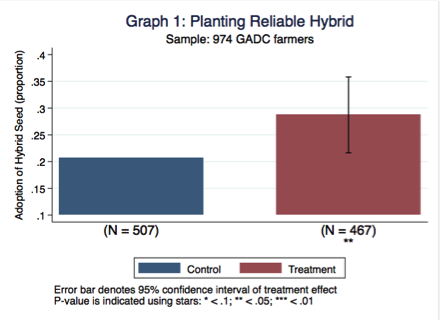
Offering Inputs for Sale When Farmers Have Liquidity Can Drive Up Adoption
Organizations : IDinsight, TechnoServe
Project Overview
Project Summary
Farmers were given the opportunity to receive partial payment for cash crop sales in the form of high-quality hybrid maize seed at the time of sale.
Impact
Adoption of reliable hybrid maize seed increased by 8 percentage points (40%), with 28 percent of treatment farmers adopting reliable hybrid seed, and 20 percent of control farmers doing so.
Cost
Costs were minimal since seeds were sold for cash.
Challenge
Improved agricultural technologies and inputs can raise productivity and incomes for smallholder farmers, and simultaneously drive down extension and buying costs for agribusinesses that source from these farmers. However, the adoption of promising technologies and inputs by smallholder farmers remains low in many African settings. Potential barriers to adoption are well documented, and include those explained by traditional economic theories (missing markets, market inefficiencies, etc.) and newer behavioral explanations (limited self control, present biased decision making, etc.).
Design
To overcome these barriers to adoption in the context of hybrid maize seeds, GADC, an agribusiness based in Northern Uganda, offered farmers the option to receive partial payment for cash crop sales in the form of high-quality hybrid maize seed at the time of sale. When farmers came to one of 16 randomly selected GADC buying depots to sell their cash crops, some randomly selected farmers were offered the opportunity to receive a small part of their crop payment in the form of a two-kilogram bag of hybrid maize seed. The randomization was run by IDinsight, and the offer was presented by the GADC buyer using a script developed by IDinsight. Farmers who took up the offer received the two kilograms of hybrid maize seed (sufficient to plant 0.2 to 0.25 acres) at the market price of 11,000 Ugandan Shillings.
The intervention was designed to leverage GADC’s buying networks and address a range of potential constraints to hybrid seed adoption, including:
- Lack of access to cash during the planting season: GADC offered farmers the option to buy improved seeds at the time when farmers had cash in hand from the sale of their crops
- Behavioral factors such as limited self-control: GADC offered farmers the option to commit to their intention to invest in hybrid seed
- High transaction costs: GADC offered its farmers the option to buy reliable seed at a convenient time and location.
- Risk of purchasing counterfeit seed: As a trusted partner, GADC offered its farmers hybrid seed that were more likely to be perceived as genuine and reliable.
Impact
 A randomized evaluation found that this strategy increased adoption of hybrid maize seeds by 8 percentage points, from 20 to 28% adoption, with a much more pronounced impact on women.
A randomized evaluation found that this strategy increased adoption of hybrid maize seeds by 8 percentage points, from 20 to 28% adoption, with a much more pronounced impact on women.
Implementation Guidelines
Inspired to implement this design in your own work? Here are some things to think about before you get started:
- Are the behavioral drivers to the problem you are trying to solve similar to the ones described in the challenge section of this project?
- Is it feasible to adapt the design to address your problem?
- Could there be structural barriers at play that might keep the design from having the desired effect?
- Finally, we encourage you to make sure you monitor, test and take steps to iterate on designs often when either adapting them to a new context or scaling up to make sure they’re effective.
Additionally, consider the following insights from the design’s researcher:
Farmers who received and took up the offer were 47 percentage points more likely to plant reliable hybrid maize seed than farmers who did not receive the offer. However, only 16 percent of farmers who were made the offer took it up, which is a very low proportion. If we drove up the overall adoption rate of the offer, we could drive up the overall effectiveness of the behavioral intervention. Four ways to increase the adoption rate:
- A sizeable proportion of farmers who declined the offer (18%) said they needed “more time” to think and discuss with their families. We might see higher adoption rates if we made farmers aware of the offer in advance.
- Given the timing of the experiment, many farmers who did not take up the offer were receiving very small cash crop payments. If offers were made to coincide with the peak of the harvest, we might see higher adoption rates.
- The offer could be combined with other nudges and micro-incentives to increase adoption.
- We found a positive correlation between take up of the offer and agronomic knowledge. By coupling the offer with agronomic training, we could see higher acceptance of the offer.
Anecdotal evidence also suggests that farmers are less likely to buy hybrid seed if they are concerned about its reliability. As a trusted local partner, GADC was able to alleviate their concerns.
For more guidance on implementing this design, select “I want to try this” from the left drop-down menu.
Project Credits
Researchers:
Nikolaus Axmann, Associate IDinsight
Ignacio del Busto, Manager IDinsight
Kevin Leiby, Manager IDinsight
Paul Wang, Partner IDinsight
Dan Stein, Technical Advisor IDinsight



